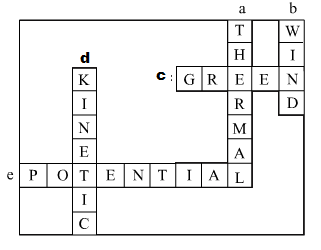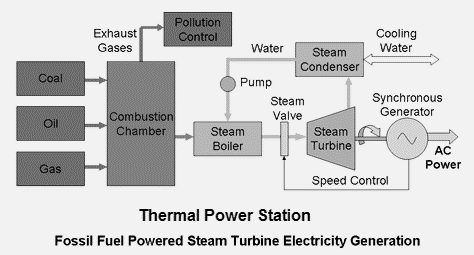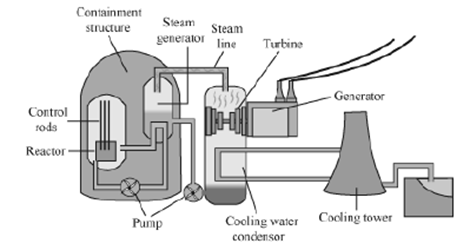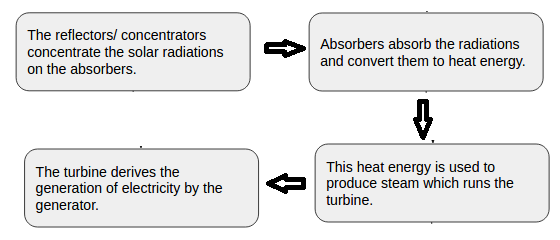Towards Green Energy
Based on Class 10-Science & Technology Part-2-Chapter-5- Maharashtra Board
Solution
Question 1:
Remake the table taking into account relation between entries in three columns.
| I | II | III |
| Coal | Potential Energy | Wind electricity plant |
| Uranium | Kinetic Energy | Hydro electric plant |
| Water Reservoir | Nuclear Energy | Thermal plant |
| Wind | Thermal Energy | Nuclear power plant |
I
II
III
Coal
Thermal Energy
Thermal plant
Uranium
Nuclear Energy
Nuclear power plant
Water Reservoir
Potential energy
Hydro electric plant
Wind
Kinetic Energy
Wind electricity plant
Question 2:
Which fuel is used in thermal power plant? What are the problems associated with this type of power generation?
Coal is used as a fuel in thermal power plant. Coal contains Chemical energy. Upon burning coal releases heat energy. This heat energy is used in thermal power plant to generate electricity. Problems associated with this type of power generation are:
Question 3:
Other than thermal power plant, which power plants use thermal energy for power generation? In what different ways is the thermal energy obtained?
Nuclear power plants and solar power plants, used thermal energy for power generation other than thermal power plants. Different ways of generating thermal energy are:
Question 4:
Which type/types of power generation involve maximum number of steps of energy conversion? In which power generation is the number minimum?
The steps of energy conversion are maximum in thermal power generation: (i) Thermal energy based power generation: It involves 5 steps of energy conversion. Fuel Energy → thermal energy → kinetic energy in steam → kinetic energy in turbine → electrical energy (ii)The power generation using solar photovoltaic cell & wind turbine involves minimum number of steps for energy conversion
Question 5:
Solve the following crossword puzzle.
a. Maximum energy generation in india is done using..... energy.
b. ...... energy is a renewable source of energy
c. Solar energy can be called.... energy.
d .... energy of wind is used in wind mills.
e. ..... energy of water in dams is used for generation of electricity.


Question 6:
Explain the difference.
a. Conventional and Non-conventional Sources of energy.
Conventional sources of energy
Non-conventional sources of energy
They are exhaustible.
They are inexhaustible
They cause pollution.
They do not cause pollution.
Not Eco friendly energy
Eco-friendly energy
Energy obtain costlier than non-conventional source of energy
Energy obtain cheaper than conventional source of energy
Non-renewable energy
Renewable energy
eg: coal, petroleum, natural
eg: wind energy, solar energy
b Thermal electricity generation and solar thermal electricity generation.
Thermal electricity generation
Solar thermal electricity generation
After burning the coal, the heat that is produced is used in the generation of thermal electricity.
Solar radiations are used in solar thermal electricity production
For producing heat, the coal is burnt in the boilers.
For production of heat, many reflectors are used which reflect the radiations of the sun into the absorbent.
The combustion of fuel produces heat. This heat converts water into steam, which is under very high temperature and pressure. By its force the turbines move. The turbines in turn are connected
to generator which rotates and produces energySun's heat convert the water into steam that rotates the turbine. The turbines then rotate the generators. This generates the electricity,
It uses non-renewable source of energy for electricity generation
It uses renewable source of energy
This method of electricity generation is not eco friendly. It causes air pollution.
This is eco friendly method of electricity generation. It does not cause air pollution.
This method requires maintenance.
This method does not require maintenance.
Question 7:
What is meant by green energy? Which energy sources can be called as green energy sources and why? Give examples.
Green energy is that energy which does not pollute the environment and is renewable in nature. The energy sources such as sunlight, wind, rain, tides, etc. can be called as green energy. This is because these are readily available on Earth, can be naturally replenished and do not even harm the environment much.
Question 8:
Explain the following sentences.
a. Energy obtained from fossil fuels is not green energy.
Thus, it can be said that energy obtained from fossil fuels is not green energy.
b. Saving energy is the need of the hour.
Lot of research is being done in the field of green energy, but the tremendous human population always is in need of more energy. Therefore, each and every person should save the energy, as saving energy is the need of the hour.
Question 9:
Answer the following questions.
a. How can we get the required amount of energy by connecting solar panels?
b. What are the advantages and limitations of solar energy?
Advantages of solar energy: Limitations of solar energy:
Question 10:
Explain with diagram step-by-step energy conversion in
1. Thermal power plant
Chemical energy in coal → Thermal energy → Kinetic energy in steam → Kinetic energy in turbine → Electrical energy

2. Nuclear Power Plant. The steps of energy conversion are:
Nuclear energy → Thermal energy →Kinetic energy in steam → Kinetic energy in turbine → Electrical energy
3. Solar thermal power plant Thermal energy in radiation → Kinetic energy in steam→ Kinetic energy in turbine → Electrical energy

4. Hydroelectric power plant
In hydroelectric power plant, the potential energy in water stored in dam is converted into kinetic energy of water. Potential energy in water→Kinetic energy in flowing water→Kinetic energy in turbine→Electrical energy
Question 11:
Give scientific reasons
a. The construction of turbine is different for different types of power plants.
Generator works on electromagnetic induction. For this generator must be rotated. Turbine is used to rotate the generator. For rotation of turbine energy is needed. The construction of turbine is different for different types of power plants. This depends on the type of energy source used for driving the turbine. Like in thermal power plants, steam turbine is used whereas in hydro-power plant, water turbine is used.
b. It is absolutely necessary to control the fission reaction in nuclear power plants.
Thus, it is absolutely necessary to control the fission reaction in nuclear power plants.
c. Hydroelectric energy, solar energy and wind energy are called renewable energies. Hydroelectric energy, solar energy and wind energy are called renewable energies because they are obtained from water reservoirs, sun and the wind. These energies are inexhaustible, sustainable and abundant in nature and can be regenerated or replenished again and again. These will never extinct even with their excessive use.
d. It is possible to produce energy from mW to MW using solar photovoltaic cells.
Solar photovoltaic cells can be arranged according to the requirement of electric power. Thus, it is possible to produce energy from mW to MW using solar photovoltaic cells.
Question 12:
Draw a schematic diagram of solar thermal electric energy generation.
The schematic diagram of solar thermal electric energy generation

Question 13:
Give your opinion about whether hydro electric plants are environment friendly or not?
All the above facts give an impression that hydroelectric power generation is eco-friendly but it is not.
Question 14:
Draw neat and labelled diagrams.
a. Energy transformation in solar thermal electric energy generation.
Thermal energy in radiation → Kinetic energy in steam → Kinetic energy in turbine → Electrical energy

b. One solar panel produces a potential difference of 18 V and current of 3A. Discribe how you can obtain a potential difference of 72 Volts and current of 9 A with a solar array using solar panels. You can use sign of a battery for a solar panel.
We can obtain a potential difference of 72 V by forming a string of 4 solar panels in series. Now, to obtain current of 9 A, connect 3 such identical strings in parallel. The same has been shown below.

Question 15:
Write short note on
Electrical energy generation and environment.
Useful links :
| Main Page : - Maharashtra Board Class 10 Science & Technology Part-1,Part-2 - All chapters notes, solutions, videos, test, pdf.
Books : MSBSHSE -Class 10th Science Text Books – Chapter wise PDF for download Previous Chapter : Chapter-4-Environmental management - Online Solution Next Chapter :Chapter-6-Animal Classification - Online Solution |
Good